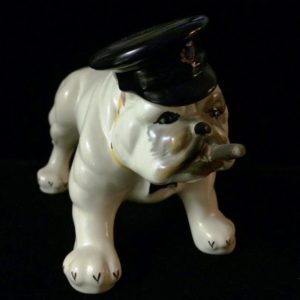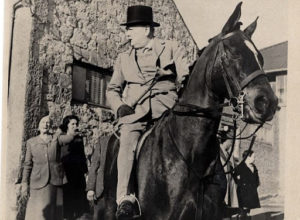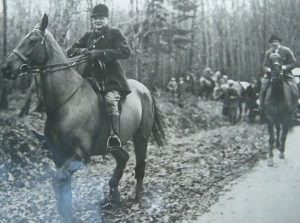Finest Hour 178
All Creatures Great and Small: The Animals of Chartwell
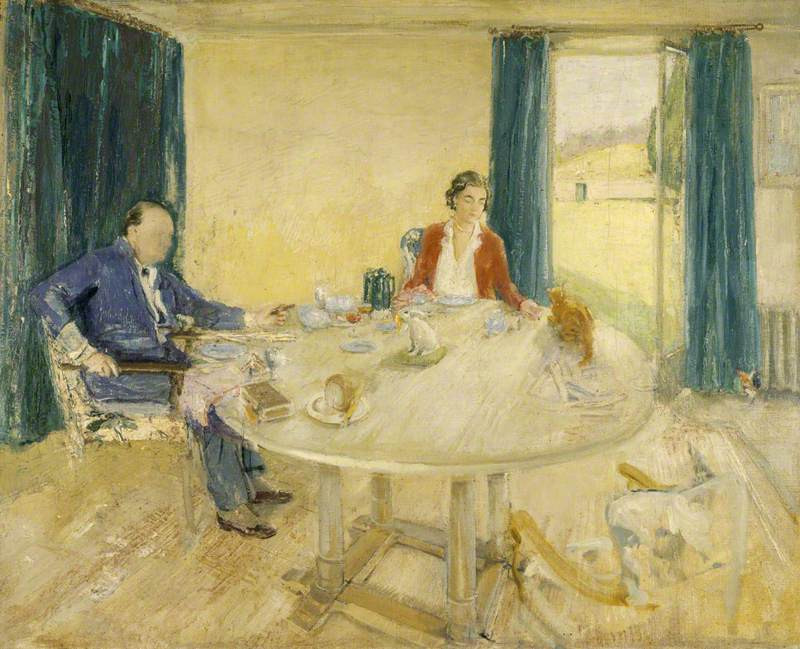
Painting of the Churchills at Chartwell by William Nicholson
January 1, 1970
Finest Hour 178, Fall 2018
Page 19
Jock VI works for the National Trust. He took up his duties as the official Chartwell mascot in the spring of 2014. You can follow him on Facebook at “Jock of Chartwell.”
Hello and welcome to this special issue of Finest Hour, which looks at my home in Kent. My name is Jock or more formally Jock VI. I proudly work for the National Trust, the charitable organization that owns and maintains many historic properties in the United Kingdom.
Shortly after the Second World War, Chartwell was purchased from Winston Churchill by a group of his friends who donated the property to the National Trust with the proviso that Mr. Churchill should be allowed to stay in residence for the remainder of his life. After her husband’s death in January 1965, Lady Churchill vacated the house, which she had long been preparing for its new role as a museum dedicated to the memory of Sir Winston. Chartwell opened to the public in June of the following year, and has now been one of the most frequently visited Trust properties for more than fifty years.
On hand to greet the first visitors was my predecessor Jock I. Mr. Churchill owned many pets throughout his life for he dearly loved those of us in the animal community. In very old age, he received the birthday gift of an orange marmalade cat. This was a present from his former secretary Sir John “Jock” Colville. Thus Jock I came to reside at Chartwell. Sir Winston, as he was by then, loved his new friend so much that he expressed the desire for a similar such feline always to be in residence at his country house when it opened to the public.
And so it has come to pass that I am the sixth in the line of official Chartwell mascots. I took over from Jock V upon his retirement in 2014. At the time I was living with Croydon Animal Samaritans and quite young. Nevertheless, when I saw the opening for the position, I applied and was immediately accepted. One of the benefits to the job, apart from meeting and greeting Churchillians from all over the world, is the inclusion of a grace-and-favour residence. I live with Mr. and Mrs. Carter in the flat above the shop—that is the attic space of the main residence.
Having worked at Chartwell for some time now, I have been able to familiarize myself with the other animals in residence as well as learn much about our predecessors including those of the most superior species. I would like to tell you about them.
Feline Fraternity
Marmalade cats at Chartwell go back to before the war. In 1933 the official cat in residence was Tango. A fine likeness of him was created by the artist William Nicholson who had been commissioned to do a painting of Mr. and Mrs. Churchill to mark their silver wedding anniversary. Tango appears in the portrait on the breakfast table with the master and lady of the house although in truth they never did have breakfast together. Mr. Nicholson also drew a fine study of Tango curled up asleep.
During the war, Chartwell had to be shuttered while the Churchills lived in official residences in London. At Downing Street there was a house cat named Nelson who typically curled up on the Prime Minister’s bed. After the war, a black cat wandered into Number 10 on the very day that the Churchills moved in for the second time, when Mr. Churchill became Prime Minister again in October of 1951. Whisky, as he was named, settled in to become a great favourite for some years until one day he disappeared as mysteriously as he arrived.
At Chartwell after the war, another ginger cat took up residence and was named Marmalade. Half wild, he supported himself on a diet of voles, birds, and other small creatures. Mrs. Churchill disliked him intensely and at first would not have him in the house. But Marmalade knew his man and ingratiated himself with Mr. Churchill by rubbing up against his legs when he sat in the garden. Soon he was in the main residence being fed fish by the master himself. This did not, however, quite satiate Marmalade’s appetite for wild creatures, an indiscretion largely kept from Mr. Churchill.
When Jock I arrived in the early 1960s, he was very young. The nursing staff took charge of his care. At 28 Hyde Park Gate, the family home in London, Jock knew the routine very well. At 1 pm, he would take up his position outside Mr. Churchill’s bedroom door knowing that his master was about to emerge for his pre-luncheon aperitif. As Mr. Churchill made his way to the drawing-room, Jock walked two paces in front with tail erect, a proud escort. While Mr. Churchill sat in his chair enjoying his drink, Jock curled up at his feet. The two then made their way to the dining room where Jock ate out of a bowl set on a placemat decorated by an image of a black cat.
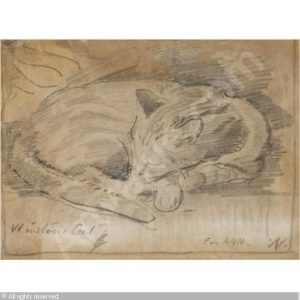
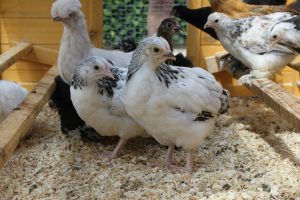
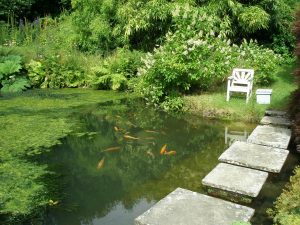
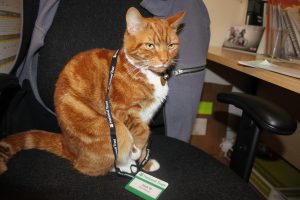
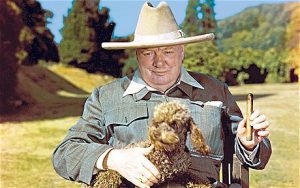
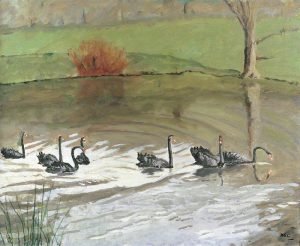
Canine Companions
It t must be said that Mr. Churchill dearly loved dogs, and thus it was necessary for my predecessors to cohabit with such company. Mr. Punch, a Pug owned by Mr. Churchill’s youngest daughter Mary, was in residence when Charlie Chaplin visited Chartwell and found himself immortalized in a famous family photograph outside the front door.
Mr. Churchill himself had a reddish-brown toy poodle named Rufus who accompanied his master everywhere, including on the drives between Chartwell and London. Sadly, Rufus was run down by a vehicle in Brighton during the 1947 Conservative Party Conference. He was buried at the foot of the stairs leading up to the croquet lawn at Chartwell. Deeply upset by this tragedy, Mr. Churchill soon acquired another poodle, whom he named Rufus II. When the two walked the grounds and came to the resting place of Rufus I, the old man would tap the gravestone and say, “There also, my dear Rufus, will you find a resting-place when you go to join your predecessor.” Not only did this come to pass, my illustrious predecessor Jock I now lies buried at this same location.
Rufus II slept on Mr. Churchill’s bed and even joined the family in the dining room where a Persian carpet was laid out on the floor beside Mr. Churchill’s seat. Upon this carpet, the butler would set the dog’s bowl. The first course could not be served before this ritual took place. Perhaps the fine dining did for Rufus as he developed tooth decay and stomach trouble that resulted in unpleasant smells. For this reason he was eventually banned from the Churchills’ stately London address and would remain at Chartwell in the care of Mrs. Churchill’s secretary Grace Hamblin when the Churchills were away from their primary residence.
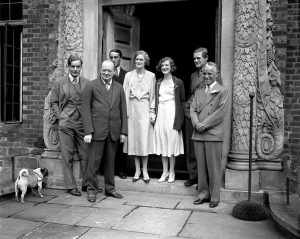
Fine Feathered Friends
Birds have long been a feature of the Chartwell menagerie. Before the war, a parrot described by Mary Churchill as a “singularly disagreeable African Grey” was in residence. At the same time, Mary made a business of breeding budgerigars. (She briefly had a side business breeding goats, but there were not many takers for these.) The budgies were kept in cages at the top of the orchard and made quite a din. Yet they were far enough away from the house not to disturb residents, and their azure blue and brilliant green plumage made them a popular feature when visitors toured the Chartwell grounds.
During the 1950s Lord Montgomery, who also bred budgies, presented Mr. Churchill with a bird of his own. Thus began the reign of Toby who became inseparable from Mr. Churchill. Toby frequently perched on the head and shoulders not only of his master but of guests as well. This sometimes resulted in unfortunate but not unforeseen outcomes. Mr. R. A. Butler, the Chancellor of the Exchequer at the time, found himself the victim of one of Toby’s indiscretions and lamented, “The things I do for England.”
Toby spoke a bit and chirped a good deal more. He fought with his own reflection in the silver pepper pot, and nibbled at the pages of books that Mr. Churchill had borrowed from the London Library. Special arrangements were made for Toby to accompany Mr. Churchill on his many visits to the south of France. Evidently, Toby took a liking to the climate, for one day he flew out of an open window in the penthouse suite of the Hotel de Paris in Monte Carlo and was never seen again, although many false sightings were claimed.
Budgies, however, were not the only birds at Chartwell. Residing on the ground were black swans first given to Mr. Churchill by Sir Philip Sassoon in the 1920s. After the war, new birds were donated by the people of Western Australia. These handsome creatures lived on the ponds at the bottom of the valley below the residence. Mr. Churchill himself had overseen the construction of these ponds in the 1930s and had kept Mrs. Churchill, who was travelling, informed about the progress of construction in a series of letters he called “Chartwell Bulletins.”
Mr. Churchill was always certain to show off the black swans to his guests. He also enjoyed feeding the birds, which—although large and fearless—became prey for the local foxes. Additionally, the wild animals would sometimes take it into their minds to fly off in search of a new home like Toby. The loss of just one of his beloved birds always caused Mr. Churchill great sadness. Nevertheless, black swans have become a permanent and popular feature of Chartwell. Just this year we received two new swans, which came to us from nearby Leeds Castle. The flock there began with the donation of birds from Mr. Churchill, so now the Castle is returning the gesture.
We also welcomed this year a new group of chickens to take up residence in the kitchen garden. These are no ordinary henhouse birds but a variety of fancy Bantam breeds. Appropriately, their home was named by Mr. Churchill “Chickenham Palace.”
Les Poissons
Mr. Churchill’s favourite place for meditation at Chartwell was in a chair next to his goldfish pond. Here he would feed his Golden Orfe, who swam among the ordinary goldfish, with maggots that were supplied regularly in a tin can. Mary Churchill remembered the original school taking up residence before the war. By the 1950s some of these fish were quite large and up to twenty years old.
At one point the fish were attacked by a fungal disease and required individual treatment—all 164 of them. Mr. Churchill supervised the task from his chair while family and staff pitched in. Diana, Mr. Churchill’s eldest daughter, without hesitation lifted her skirt, tucked in her undergarments, and stepped into the cold water. When Mr. Churchill complained that the job was not being completed fast enough, his chauffeur spoke up to say, “Give us the tools and we will finish the job!”
The goldfish have remained a permanent feature of the grounds. Mr. Churchill loved them so much that he immortalized them in oils twice. “The Goldfish Pool at Chartwell” is regarded as one of his greatest paintings. It remained in the possession of his daughter Mary until she passed away. The last painting that he ever completed was also of his beloved goldfish. He gave this to his bodyguard and painting companion Edmund Murray (see p. 54).
Chevalier
Horses were long an important part of Mr. Churchill’s life. Trained as a cavalry officer, he spent well beyond his means to maintain a stable of polo ponies while a young soldier stationed in India. He continued to pursue the sport up to the age of fifty. Thereafter, as master of Chartwell, he and Mrs. Churchill presented their daughter Mary with a horse before the war. After the conflict, Mr. Churchill owned a number of racehorses, which he kept at a stud farm that he visited regularly near Chartwell. Mr. Churchill carefully inspected each horse as well as the stud book and made knowledgeable comments about each horse’s costs and probable current value. His most successful horse, Colonist II, won Mr. Churchill a good deal of prize money.
Mr. Churchill’s final visit to the stud farm took place in the autumn of 1964. Dressed in a green siren suit, he put on a grey overcoat and large Stetson pulled down over his eyes. At the farm, stable boys stood ready to parade each horse. A wooden chair was set out for Mr. Churchill and next to this was placed a large plate of sliced apples. As each horse was brought round for his inspection, Mr. Churchill stroked the animal for the last time and fed him a slice of apple.
Other Creatures
Mr. Churchill’s love for animals extended well beyond the traditional human companions of cats, dogs, birds, fish, and horses. The large Butterfly House near the main residence was another popular stop when guests were shown the grounds. And despite the predations made against the swans, there were even two fox cubs briefly in residence just before the war. These were called Charles-James and Victoria. With the approach of hostilities in 1939, the foxes were by steps successfully adapted to the wild.
Two final stories show the passion that Mr. Churchill felt for all God’s creatures great and small. The first was recently told me by Lady Williams, who as Jane Portal worked as a secretary for Mr. Churchill from 1949 to 1955. She was once taking dictation from Mr. Churchill while they rode together in a car between Chartwell and London when the vehicle struck and killed a badger in the road. Mr. Churchill insisted that the car stop so that he could get out and hold the poor creature in his arms. In an unusual tribute, he had the badger skinned, and the pelt was thereafter displayed on his bedroom wall. He would tell people, “It was not the badger’s fault.”
The final story shows that Mr. Churchill truly understood the position of all animals in our world. Once, when the croquet lawn became infested with worms, Mrs. Churchill had insecticide laid down. As she showed her husband the fatal results, he became very cross and said, “You know it is very wrong to kill the poor worms for they all have their place in nature’s grand design.”
I am very grateful to have my place at Chartwell.
Subscribe
WANT MORE?
Get the Churchill Bulletin delivered to your inbox once a month.

